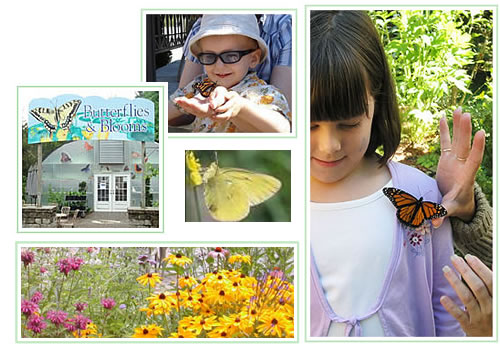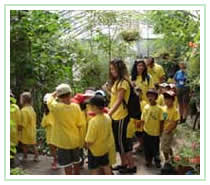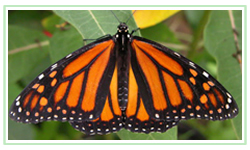|
"Butterflies & Blooms" Butterfly Conservatory
☼ Butterflies A-Z ☼ Butterfly Releases ☼ Creating A Butterfly Garden ☼ Did You Know? ☼ Testimonial ☼
 "BUTTERFLIES & BLOOMS" "BUTTERFLIES & BLOOMS"
BUTTERFLY
CONSERVATORY
|
 Closed for the Season Closed for the Season
We are sad to announce
that the butterflies will not
 be landing at Blue Willow be landing at Blue Willow
Garden Centre this
year. |
 |
MONARCH RELEASE TAG DAY
Sorry, but this event has been
cancelled for the 2013 season. |
Georgina's own Butterfly Conservatory will not be opening this year
Sadly, after 11 great seasons, the Butterflies and Blooms Butterfly Conservatory will close it’s doors. Due in
part to declining group bookings, staffing issues and economic conditions (among other reasons) we were
forced to make the heart-breaking decision. We thank you for your past support and apologize for any
inconvenience this may cause.
However, we are still the ‘Butterfly & Garden Experts’. Our Garden Centre still offers a great selection of
butterfly attracting plants, giftware, books and information about butterflies and more. Please feel free to
stay and browse, use our children’s play/park area and enjoy your time here. Be sure to check for possible
changes to our business hours beginning July 1st.
So keep in touch, we would be pleased to keep you informed.

Butterfly Releases
We provide butterfly lovers another service, Butterfly Releases (Monarch and Painted Ladies) for special
occasions or important events,
such as
weddings, birthday parties, memorial tributes, and testimonial gatherings or send-off
ceremonials, and salutations. Different presentation format packages are
available. Bookings until June 30th. Call us for more details at 905-722-5849
Creating A Butterfly Garden
☼ Creating A Butterfly Garden [pdf]
Butterflies exist naturally throughout Canada. Species vary from region to region. With careful planning, flowering nectar plants which are their favorite food source can be introduced into the garden, therefore enticing them to visit. As gardeners, we can provide nutrition for them and also give ourselves an opportunity to view these fascinating insects.
 Butterflies are attracted by and lured to plants through smells and scents. Bright, colorful flowers with strong fragrances may be filled with nectar, inviting butterflies to land and attempt to siphon nectar. Plants benefit from a butterfly visit for they may be pollinated. Butterflies are attracted by and lured to plants through smells and scents. Bright, colorful flowers with strong fragrances may be filled with nectar, inviting butterflies to land and attempt to siphon nectar. Plants benefit from a butterfly visit for they may be pollinated.
Butterflies love to sunbathe. Since they are cold blooded insects, they like to bask in the sun on warm stones, therefore a garden site with good exposure filled with large stones to capture heat is a good butterfly site condition.
For centuries butterflies have attracted people to their magnificent array of shapes and colours. Today, butterfly watching is a growing pastime second only to bird watching.
By properly creating a butterfly garden habitat, containing nectar flowers for the adults and proper food plants for their offspring (caterpillars), you will do your part to help conserve these beautiful creatures. They will add beauty to your living space and pollinate  your flowers. your flowers.
By contacting a local nature club or environment society in your area, you can get information as to the particular species that frequent your area. Butterfly books also give geographic ranges of species.
Your Butterfly Garden can be either formal or informal. Regardless of your choice remember the main elements for your Butterfly Garden:
- butterflies need a good source of nectar bearing flowers
- food plants on which to lay their eggs
- a sunny location sheltered from the wind
- a source of water
- an area which is undisturbed
- pesticides and herbicides cannot be used in or near your butterfly garden
Did You Know?
- Butterflies taste with their feet.

- They feed through a long thin straw like tube called a proboscis which they sink into the flower to suck up nectar. When not in use, it's coiled up inside the head. Some Butterflies feed on the juices of rotting fruit.
- The average life-span of a butterfly is two to three weeks. The exception are migrating species like our own Monarchs which can live up to six months.
- Butterfly wings are made of tiny scales arranged like shingles as seen on a roof of a house. These scales are what establishes the colours and patterns on the wings. By touching the wings, the scales could come off, it looks like powder and without the scales the wings are very fragile.
- A person who collects many types of insects is called an Entomologist.
- Some butterflies and moths live through the winter as eggs, others in the larvae and chrysalis stage (Caterpillar),
 while some as adults (butterflies). The adults often hide in leaf piles, under loose bark and stones. while some as adults (butterflies). The adults often hide in leaf piles, under loose bark and stones.
- Some caterpillars protect themselves by being covered with hair or spines. Some caterpillars also contain poisonous or distasteful juices.
- Butterflies are insects because they have 6 legs.
- In some countries butterflies are now protected by government laws because of their rarity.
- The upper wings of butterflies and moths are called "forewings" while the lower wings are called "hindwings".
- Most butterflies fly during the day while most moths fly at night.
- Many male butterflies have special scent scales on their wings to carry perfume. This helps in attracting a mate.
- Butterflies usually have thin slender bodies, while moths have fat, furry bodies.
 Some butterfly and moth enemies are: spiders, birds, snakes, frogs. Some butterfly and moth enemies are: spiders, birds, snakes, frogs.- The spanish word for butterfly is Mariposa
- The french word for butterfly is Papillon
- Some butterflies and moths make crackling or rattling sounds when alarmed or disturbed. This scares off predators (enemies).
- As a caterpillar grows it sheds its skin several times, this is also known as "molting".
- The earliest fossil records of butterflies and moths date to 100 million years ago.
- After hatching from a chrysalis or cocoon the butterfly or moth begins to pump blood into their folded wings. Once the wings have expanded to their full size and dried, the specimen is as big as it will ever be.
Testimonial
Roy Gucciardi
Blue Willow Garden Design Centre
Dear Sir,
My mother and I recently had a most enjoyable afternoon at your new Butterfly Conservatory. In the past few weeks I have also attended (other) butterfly conservatories ... and must say that I enjoyed the Blue Willow Conservatory the most because of the very informative tour you gave. The displays in the outer area were interesting, and it was remarkable to be able to hold a still-wriggling chrysalis and to observe newly hatched butterflies.
Inside the conservatory it was a thrill to see all the caterpillars, yet also peaceful to walk around the beautiful plants, flowers and statuary while butterflies fluttered about (and occasionally hitched a ride on my pant leg).
With many, many thanks for an extremely enjoyable tour.
Jeanne C.
Toronto, ON
|
|
|








